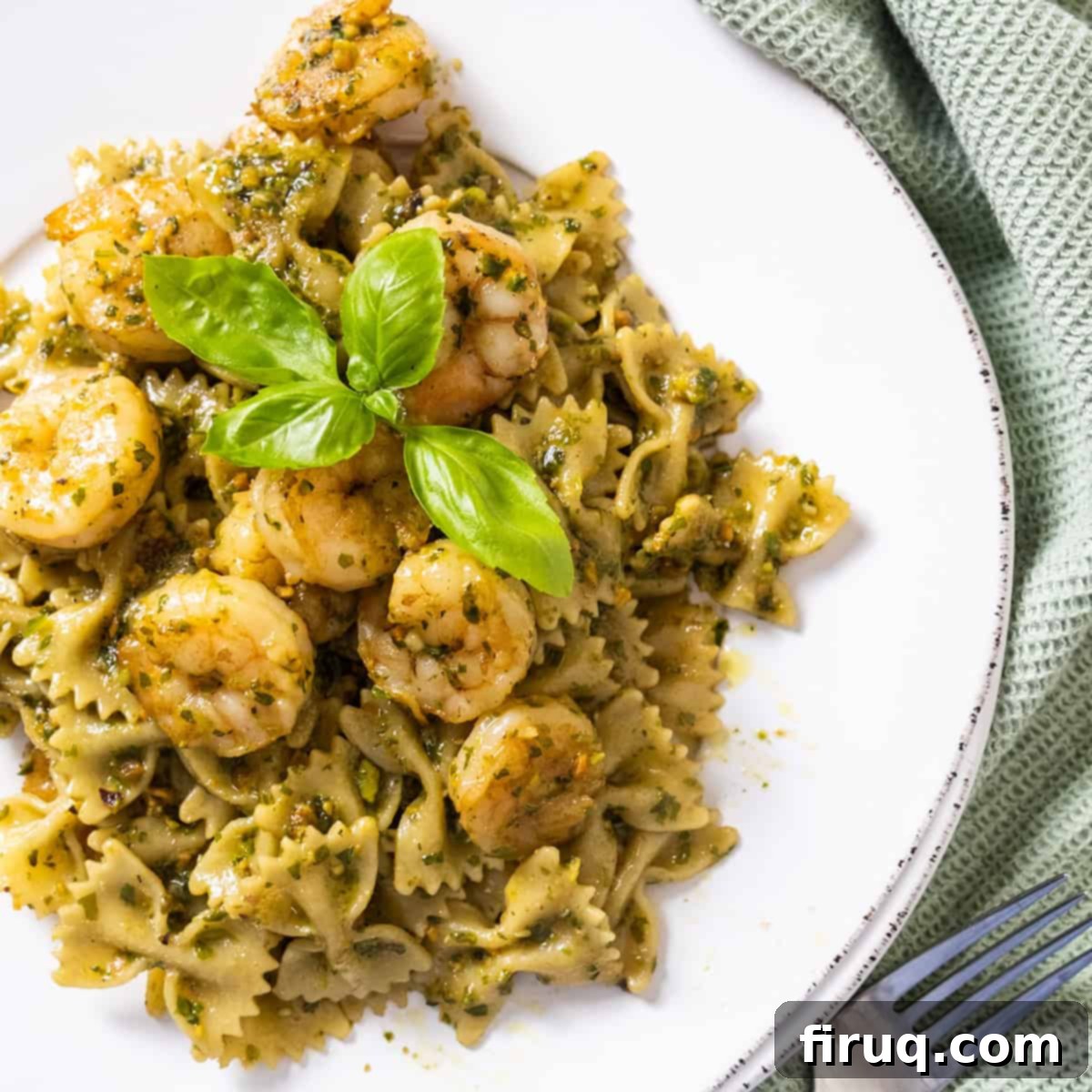Creamy Pesto Shrimp Pasta: Your Go-To Easy & Flavorful Summer Meal
Dive into the vibrant flavors of summer with this incredibly easy and delicious Creamy Pesto Shrimp Pasta. This dish perfectly marries plump, tenderly seared shrimp with a rich, aromatic pesto sauce, all tossed with your favorite pasta. It’s a light yet satisfying meal that comes together quickly, making it ideal for busy weeknights or a relaxed weekend dinner.
Looking for more fantastic summer seafood recipes? Don’t miss our Linguine with Red Clam Sauce, bursting with fresh cherry tomatoes and savory clam flavor!
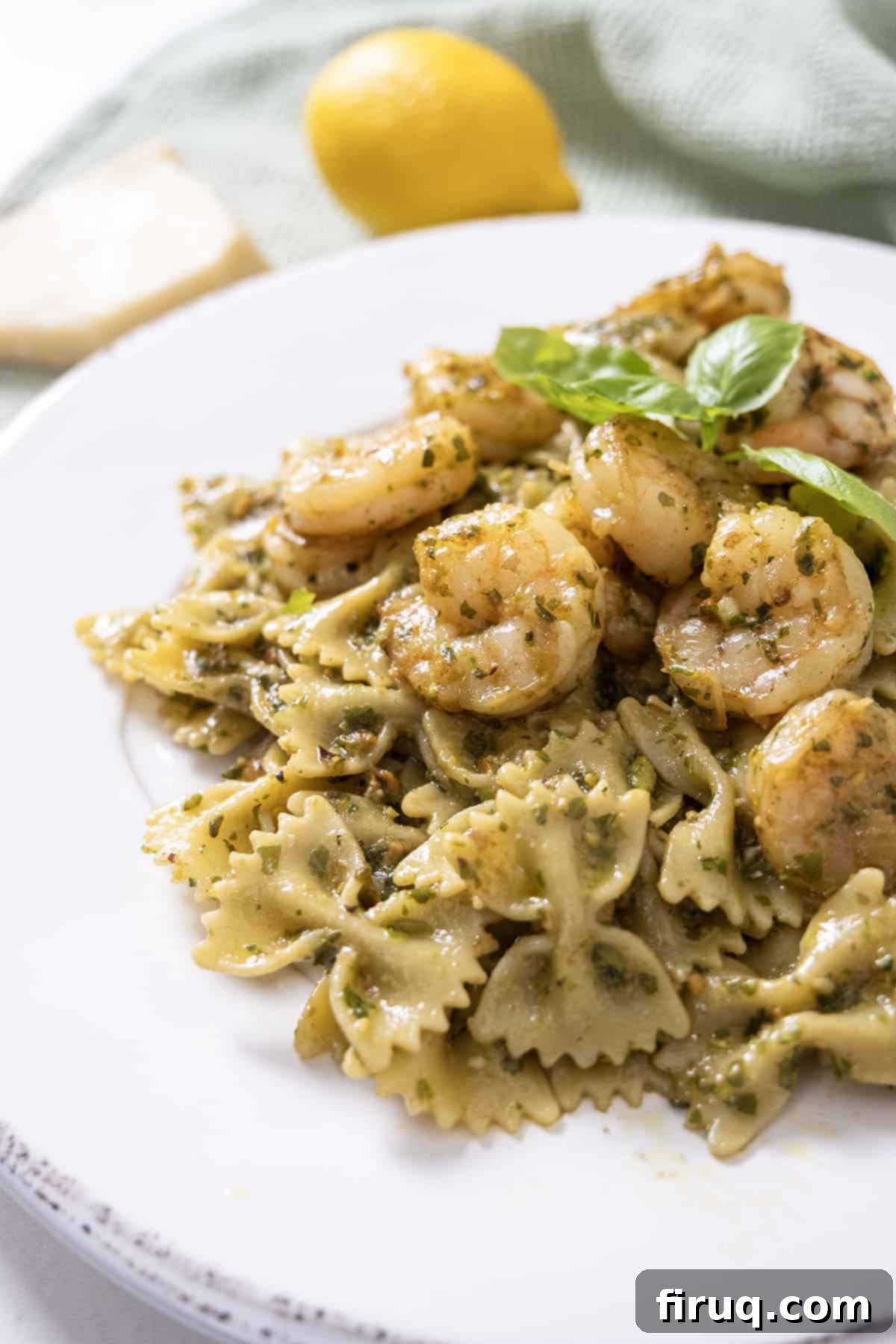
Craving more delicious summer pasta recipes? You’ll love our Italian Summer Pasta with Zucchini or the unique flavors of Busiate with Pesto Trapanese. These dishes are perfect for utilizing seasonal ingredients and keeping your kitchen cool.
Mastering the Pesto for Your Pasta Perfection
My adoration for pesto knows no bounds; it’s truly one of my all-time favorite flavors. This Creamy Pesto Shrimp Pasta showcases pesto in its most delightful form, creating a creamy texture that perfectly complements the delicate shrimp. The secret to achieving a luxurious, non-oily pesto sauce that clings beautifully to your pasta lies in one simple ingredient: starchy pasta water.
When you finish cooking the pasta directly in the pan with the pesto and a splash of that magical pasta water, the starches released from the pasta work their wonders. They emulsify with the olive oil in the pesto, creating a smooth, rich, and incredibly creamy sauce that isn’t greasy. This technique allows the sauce to thicken and develop an unmatched depth of flavor, much like in our popular Artichoke Pesto Pasta.
The beauty of this creamy pesto shrimp pasta recipe is its flexibility with pesto. Whether you prefer a homemade classic basil pesto, or need to get creative with what you have on hand, it will work! If your basil plant is looking a little sparse, consider making a vibrant Pea Pesto. Or, if you happen to have extra pesto, don’t let it go to waste – it’s fantastic for recipes like Pesto Stuffed Chicken. You can even experiment with sun-dried tomato pesto or arugula pesto for different flavor profiles. Preparing your pesto ahead of time, or even freezing it in batches, makes this recipe an absolute breeze on a busy evening.
Key Ingredients & Smart Substitutions for the Best Flavor
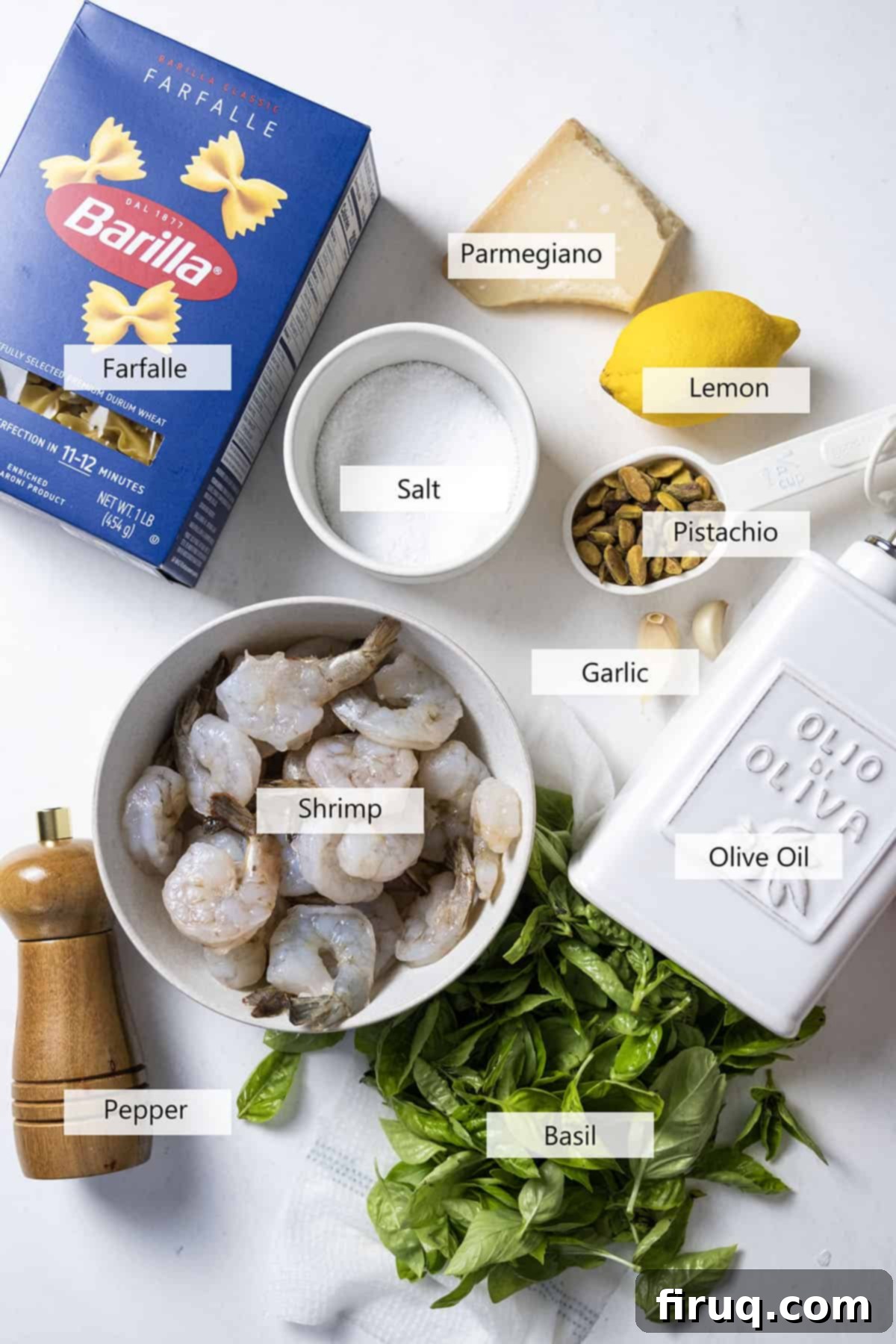
Shrimp: For the most tender and flavorful results, always opt for raw shrimp. Avoid pre-cooked shrimp as it tends to be tough, rubbery, and can lack significant flavor once reheated. While peeling and deveining your own shrimp can be meditative, a great time-saver is to buy already peeled and deveined raw shrimp. This allows you to jump straight to the crucial marinating step, which truly elevates the taste.
Pesto: The choice of pesto can truly transform this dish. While a classic basil pesto is always a winner, my personal preference leans towards Pistachio Pesto. Pistachios add a unique richness and a subtle nutty flavor that I find irresistible, and they’re a staple in my pantry. If you’re making your own, don’t be shy about adjusting the garlic or lemon to suit your taste. For convenience, a high-quality store-bought pesto can also be a fantastic shortcut.
Pasta: Farfalle, also known as bow-tie pasta, is my top choice for this recipe due to its beautiful shape and how well it holds the creamy pesto sauce. However, feel free to use any pasta shape you prefer! Other excellent options include rigatoni or penne, which have ridges and tubes to trap the sauce. If you prefer a flatter, more substantial bite, orecchiette (little ears) are superb. Don’t be afraid to experiment with whole wheat or gluten-free pasta varieties if that suits your dietary needs.
Olive Oil: Extra Virgin Olive Oil (EVOO) is a must for both the pesto and searing the shrimp. Its fruity, peppery notes are integral to the Mediterranean flavors of this dish.
Garlic: Freshly minced garlic for marinating the shrimp and whole cloves for the pesto provides a robust aromatic base. Don’t skimp on the garlic!
Salt: Essential for seasoning both the pasta water and the dish itself. Remember to taste as you go and adjust to your preference.
Lemon Juice: A squeeze of fresh lemon juice brightens the pesto and adds a zing that cuts through the richness, balancing the flavors beautifully.
Parmesan Cheese: Freshly grated Parmesan cheese not only adds a salty, umami depth to the pesto but also contributes to the sauce’s overall creaminess. For best results, grate it yourself rather than using pre-shredded varieties.
*Please see the recipe card below for more detailed information on ingredients and quantities.
Step-by-Step Guide to Crafting Creamy Pesto Shrimp Pasta
The beauty of this recipe lies in its straightforward approach and the ability to customize it with your favorite pesto. I often prepare a larger batch of pesto than needed and freeze it in ice cube trays for quick use in future meals, making dinner prep even faster!
Preparing Your Perfect Pesto
Step 1: To create a vibrant and flavorful pesto, begin by combining the garlic cloves, raw pistachios, salt, and fresh basil leaves in a food processor. Pulse these ingredients until they are finely chopped and well combined. Next, add the fresh lemon juice. With the food processor running on low, slowly and steadily pour in the Extra Virgin Olive Oil (EVOO). Continue processing until you achieve a smooth, emulsified consistency. Finally, stir in the grated Parmesan cheese until just combined. The pesto should not be entirely silky smooth; a slight creaminess with a pleasant hint of lumpiness from the nuts is ideal for texture.
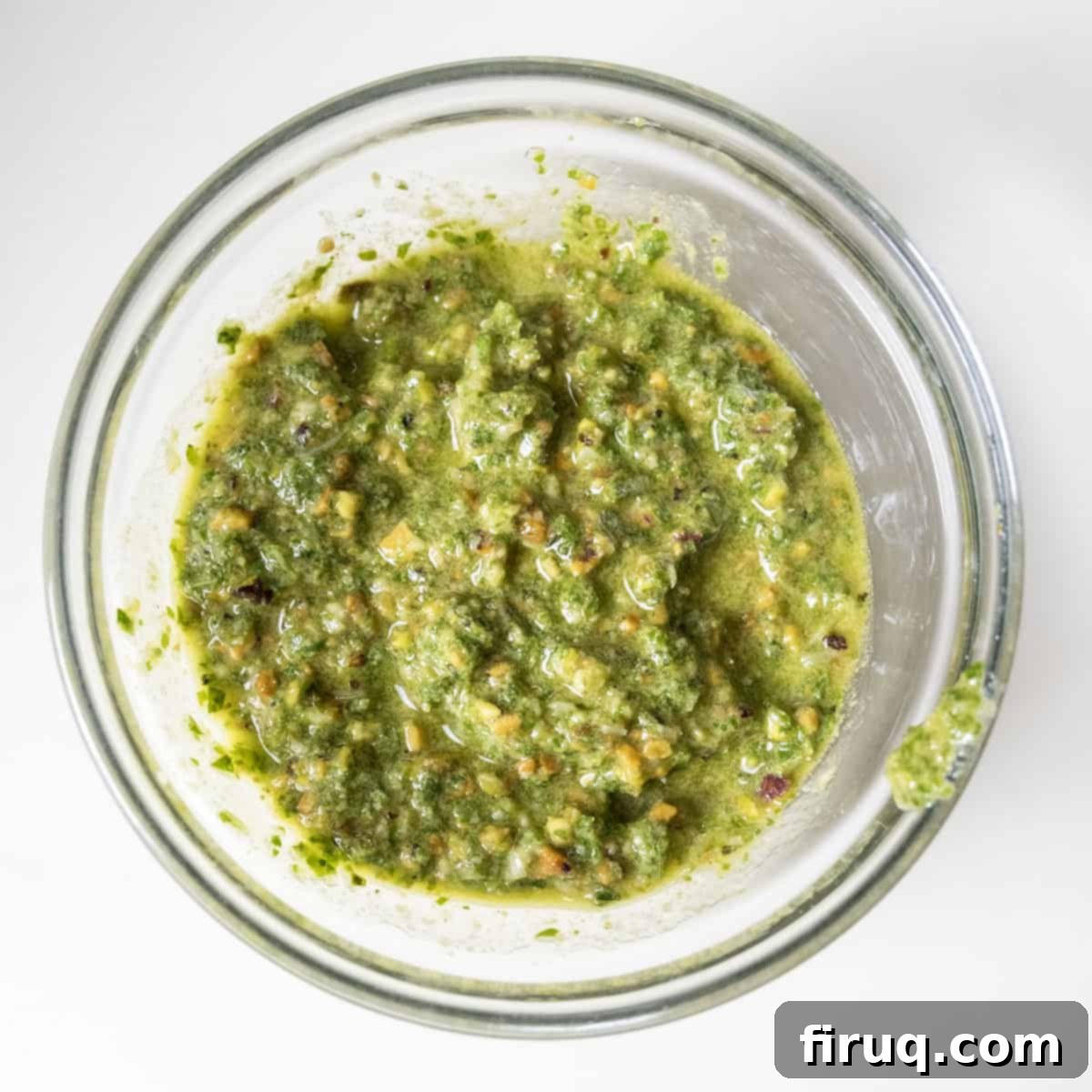
Your pesto should be creamy with a little lumpiness, not a completely smooth puree. This texture adds a wonderful mouthfeel to the finished dish.
Cooking the Shrimp and Pasta to Perfection
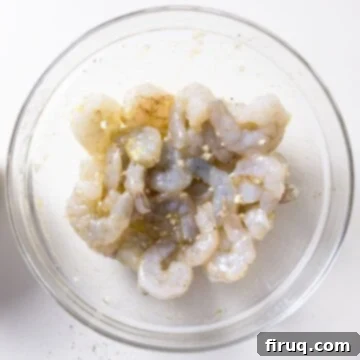
Step 2: One of the most crucial steps for incredibly flavorful shrimp is marinating. This process allows the shrimp to absorb the savory flavors and helps create those delightful brown bits at the bottom of the pan, which are essential for building a rich sauce. In a bowl, combine the raw, peeled, and deveined shrimp with 2 tablespoons of olive oil, a pinch of salt, and minced garlic. Toss everything gently to ensure the shrimp is evenly coated. Place the shrimp in the refrigerator to marinate for up to 1 hour. If you’re short on time, even 15 minutes will make a noticeable difference in flavor.
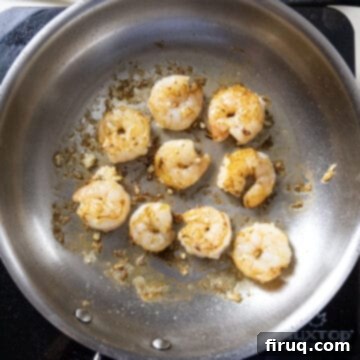
Step 3: Heat a large saucepan over medium-high heat. Once hot, add 1 tablespoon of olive oil. Sear the marinated shrimp in batches to avoid overcrowding the pan. Cook for approximately 60-90 seconds on each side until the shrimp turns opaque and develops a beautiful pink color and a slight char. Overcooking shrimp can make it rubbery, so keep a close eye on it. Once perfectly cooked, remove the seared shrimp from the pan and set it aside.
Step 4: Fill a medium-sized pot with water and bring it to a rolling boil. It’s crucial to generously salt the water – use about 2-3 tablespoons of salt. This not only seasons the pasta from within but also helps prevent it from sticking. Add your chosen pasta (farfalle in this case) and cook until it is 1 minute before al dente, as directed on the package. Before draining, make sure to save at least 1-2 cups of that starchy pasta water; it will be essential for creating the creamy sauce.
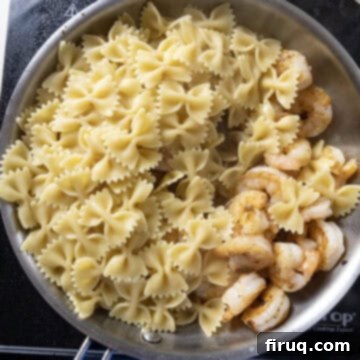
Step 5: Return to the same large saucepan where you seared the shrimp. Lower the heat to medium-low. Add about 1 cup of the reserved starchy pasta water to the pan. This will help deglaze the pan, picking up all those delicious brown bits left from the shrimp, which adds tremendous flavor to your sauce. Then, return the perfectly seared shrimp to the pan along with the strained, slightly undercooked farfalle.
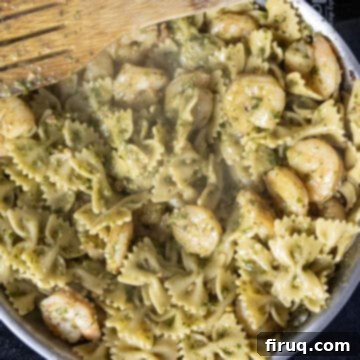
Step 6: Add your freshly made or store-bought pesto to the pan with the shrimp and pasta. Gently toss and stir everything together, allowing the pasta to finish cooking and absorb the incredible flavors of the pesto and the pan drippings. As you stir, the sauce will begin to thicken. Continue to slowly add more pasta water, a tablespoon at a time, until you achieve your desired creamy consistency. If you accidentally add too much water, simply let the sauce simmer on low heat for an extra minute or two, and it will thicken beautifully. Remove from heat immediately once the desired consistency is reached and serve hot.
This creamy pesto shrimp pasta is truly a fantastic weeknight meal. When I’m pressed for time, I simply marinate the shrimp while I’m preparing the pesto, cutting down on overall cooking time significantly. I consider myself the king of whipping up quick and satisfying pasta dinners for my family, like our Pasta with Peas and Pancetta or the lightning-fast 15-Minute Spaghetti with Garlic and Oil.
What I particularly love about this dish is that it delivers a complete meal with both protein and carbohydrates. To round out the dinner, I often serve it alongside some fresh vegetables, such as crispy Garlic Parmesan Green Beans or earthy Sautéed Rapini with Garlic. These sides complement the rich pesto flavor without overpowering it, making for a perfectly balanced and utterly delicious meal.
Pro-Tips for Perfect Creamy Pesto Shrimp Pasta
- Harness the Power of Pasta Water: The starch-rich water left over from boiling your pasta is your secret weapon for achieving a truly creamy pesto sauce. Adding this water to the pasta and pesto in the pan helps to emulsify the sauce, creating a smooth, velvety texture that coats every strand of pasta beautifully, without needing heavy cream or excess oil. It’s the Italian nonna’s trick for a reason!
- Mastering the Shrimp Sear: A good sear on your shrimp develops incredible flavor and texture. To achieve this, ensure your pan is piping hot before adding the oil and then the shrimp. You want to hear that sizzle immediately! Cook the shrimp for no more than 60-90 seconds per side until they turn opaque and pink. This quick cooking time prevents them from becoming tough and rubbery.
- Avoid Overcrowding the Pan: When searing shrimp, it’s essential to cook them in batches if necessary. If you overcrowd the pan, the temperature will drop significantly, causing the shrimp to steam rather than sear. Steamed shrimp won’t develop that beautiful golden-brown crust and rich flavor that seared shrimp does. Give each shrimp a little space to breathe and sizzle!
- Taste and Adjust: Always taste your pesto and the final pasta dish before serving. Adjust salt, pepper, or a squeeze of fresh lemon juice as needed. A little extra lemon can brighten up a rich sauce beautifully.
- Garnish for Freshness: A sprinkle of fresh basil leaves or a grating of Parmesan cheese just before serving adds a lovely fresh aroma and visual appeal to your creamy pesto shrimp pasta.
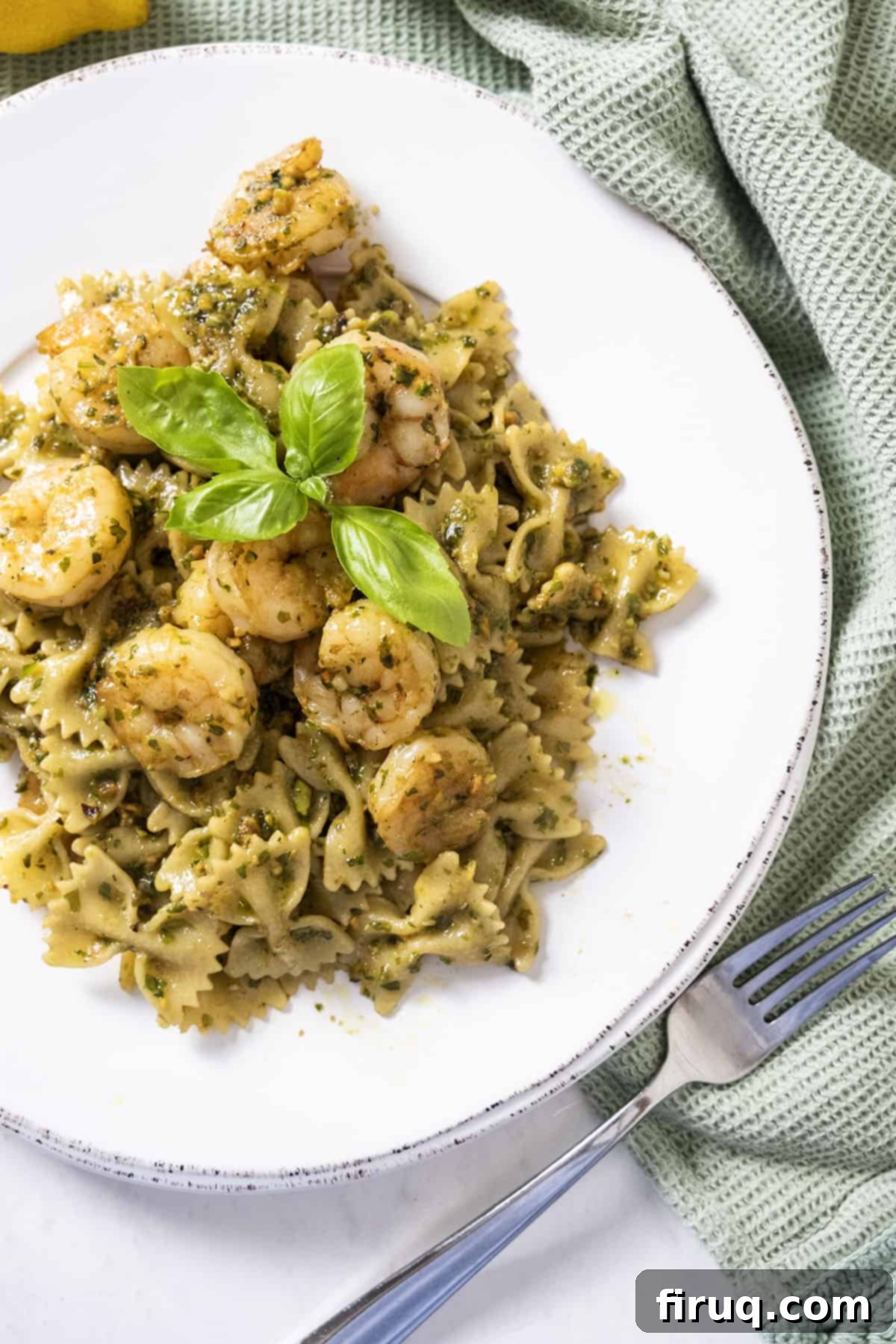
Frequently Asked Questions About Creamy Pesto Shrimp Pasta
Reheating shrimp or any seafood dish is always best done on the stovetop to preserve its texture and flavor. Bring a non-stick pan to medium heat and add a tablespoon of olive oil. Add the leftover pasta and a splash of water (or even better, a little chicken or vegetable broth) if the sauce seems too thick. Stir gently until heated through, usually just a few minutes. Avoid high heat, which can make the shrimp rubbery. While you can microwave it, the pan method yields far superior results.
Absolutely! This recipe is incredibly versatile and welcomes additional vegetables. You can easily incorporate broccoli florets, asparagus spears, spinach, cherry tomatoes, or even more peas for added color, nutrients, and texture. I recommend steaming or lightly sautéing your chosen vegetables separately after the shrimp has been seared, then tossing them into the pan with the pasta and pesto at the very end to ensure they remain crisp-tender and don’t get overcooked.
Yes, you can definitely use frozen shrimp. Just be sure to thaw it properly before marinating and cooking. The best way to thaw frozen shrimp is overnight in the refrigerator. If you’re in a hurry, you can place the sealed bag of shrimp under cold running water for about 15-20 minutes until thawed. Pat them completely dry with paper towels before marinating to ensure they sear well and don’t release too much water in the pan.
Store any leftover Creamy Pesto Shrimp Pasta in an airtight container in the refrigerator for up to 2-3 days. The flavors often meld and improve overnight, though the shrimp is always best enjoyed fresh. Make sure the pasta has cooled completely before sealing and refrigerating.
To make the pesto dairy-free, simply omit the Parmesan cheese or use a dairy-free Parmesan alternative. For a fully vegan version, you would also need to replace the shrimp with a plant-based protein like sautéed mushrooms, chickpeas, or grilled tofu. The creamy texture can still be achieved using pasta water and a good quality plant-based pesto.
More Quick & Delicious Pasta Recipes to Try
- Quick Lamb Ragu with Pappardelle
- Creamy Garlic Mushroom Pasta
- Pasta with Cauliflower
- Creamy Chicken Parmesan Pasta
If you’ve enjoyed making and tasting this Creamy Pesto Shrimp Pasta, we encourage you to explore more of our easy and quick pasta recipes! You can find a wide array of comforting and flavorful dishes on our site. Also, make sure to connect with us on Instagram @vindelgiudice or TikTok @alwaysfromscratch for daily cooking inspiration, tips, and behind-the-scenes glimpses!
📖 Recipe
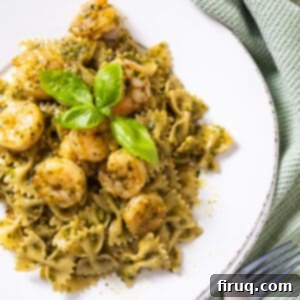
Creamy Pesto Shrimp Pasta
Vincent DelGiudiceEquipment
-
food processor
-
large sauce pan
Ingredients
- 1.5 lb raw shrimp, peeled and deveined
- 1 lb farfalle
- 2 tablespoon garlic, minced
- 3-4 tablespoon olive oil
- 1 tsp salt
For the Pesto
- 3 cups basil
- 2 cloves garlic, whole
- ½ cup raw pistachios
- 1 teaspoon salt
- 3 tablespoon lemon juice
- 1 cup parmesan cheese
- 1 cup EVOO
Instructions
For the Pesto
-
Combine garlic, pistachios, salt, and basil in a food processor and pulse until well combined. Add lemon juice and then slowly add in EVOO until you reach a smooth consistency. Then add the parmesan cheese.
Shrimp and Pasta
-
Marinate shrimp with 2 tablespoon olive oil, salt, and minced garlic in the refrigerator for up to 1 hour (or a minimum of 15 minutes if in a rush).
-
Remove the shrimp from the fridge. In a large saucepan, add 1 tablespoon of olive oil on medium-high heat. Sear the shrimp on both sides for 60-90 seconds in batches (to avoid overcrowding) and then set aside.
-
In a medium pot, bring generously salted water to a boil for the pasta. Boil the pasta until 1 minute before al dente as directed on the package. Reserve at least 1-2 cups of the starchy pasta water before draining.
-
In the same large saucepan, lower the heat to medium-low. Add ½ a cup of the starchy pasta water to the pan. Then return the seared shrimp to the pan along with the strained farfalle. Add the pesto and combine everything thoroughly. Continue to slowly add more pasta water, a tablespoon at a time, until you reach your desired creamy texture. Remove from the heat and serve immediately.
Notes
-
- Adding the pasta water to the pasta with pesto will make the pesto more of a creamy sauce. This is exactly what you want when it comes to a dish like this.
- When searing the shrimp, you want to get a good sear but avoid overcooking it. Make sure the pan is hot. Don’t overcrowd the pan with too much shrimp.
- If you’re looking for pesto recipes, try either of ours: Pistachio Pesto or Pea Pesto.
